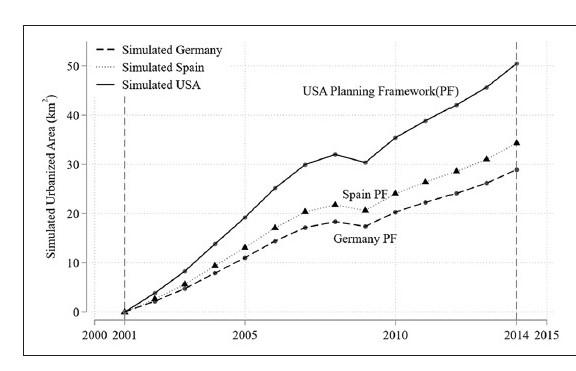← Back to Projects
Land use planning institutions
We are interested in the role that planning institutions, frameworks and the broader regulatory environment play in shaping our cities and metropolitan areas. How do institutions and policies shape spatial patterns? How can planning institutions, regulatory environments and land use policies create more sustainable and equitable spatial patterns?

A simulation of urban expansion in terms of the planning frameworks in the United States, Germany, and Spain.
For example, in a comparative analysis of the effect of planning institutions on urban structure, we constructed a composite index to measure institutional planning frameworks through objective criteria—restrictive versus permissive; binding versus nonbinding; nationally versus locally oriented—that enables comparison between countries. We also estimate a series of models to evaluate the relationship between institutional frameworks and patterns. The evidence suggests that a more centralized and coordinated planning framework produces more compact development, whereas a more decentralized and uncoordinated planning framework results in less compact development. Our simulation predicted that the average urbanized area for a hypothetical metropolitan area would increase by over 50 km2 over a roughly 15 year period if a U.S. planning framework is adopted, 35 km2 under the Spanish scenario, and 27 km2 under the German scenario (Schmidt et al, 2021).
Related work:
Siedentop, S., Schmidt, S. and Dunlop, A. (2022) Managing Urban Growth at the Regional level – a Review of the Literature, Raumforschung und Raumordnung | Spatial Research and Planning. 80(6) 659-677
Schmidt, S., Li, W., Carruthers, J., and Siedentop, S. (2021). Planning Institutions and Urban Spatial Patterns: Evidence from a Cross-National Analysis. Journal of Planning Education and Research, 0(0).
Schmidt, S., Siedentop S. and Fina, S. (2018) How effective are regions in determining urban spatial patterns? Evidence from Germany, Journal of Urban Affairs, 40:5, 639-656
Schmidt, S., Fina, S., and Siedentop, S. (2015) Post-socialist Sprawl: A Cross-Country Comparison, European Planning Studies, 23:7, 1357- 1380


